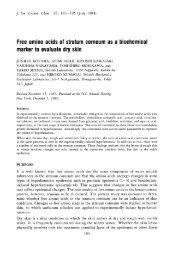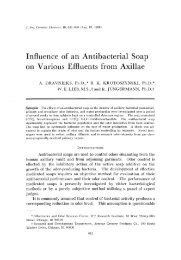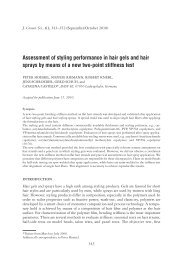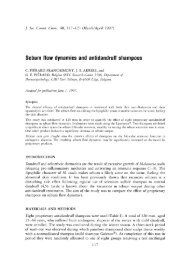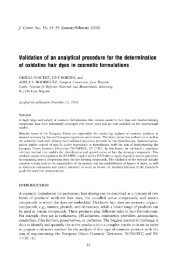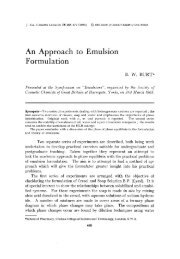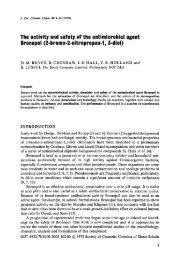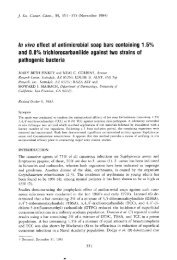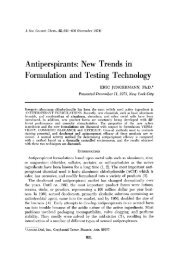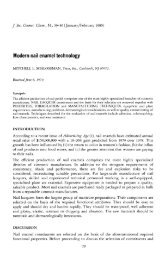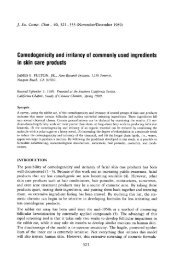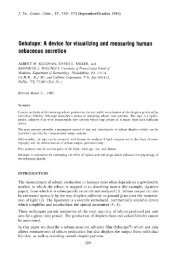A Critical Comparison of Two Procedures for Antiperspirant Evaluation
A Critical Comparison of Two Procedures for Antiperspirant Evaluation
A Critical Comparison of Two Procedures for Antiperspirant Evaluation
You also want an ePaper? Increase the reach of your titles
YUMPU automatically turns print PDFs into web optimized ePapers that Google loves.
262 JOURNAL OF THE SOCIETY OF COSMETIC CHEMISTS<br />
can likewise be controlled by additional replication (<strong>for</strong> example, by averaging<br />
data obtained on successive days or by the use <strong>of</strong> additional test subiects*<br />
).<br />
Aside from the above, the RM consistentlyields different point estimates<br />
<strong>of</strong> per cent reduction than those obtained with the SSEM, using the same<br />
posttest data. Since the latter can be shown to be correct due to the balance <strong>of</strong><br />
the experimental design, the question arises as to the source <strong>of</strong> the disagreement.<br />
Either both estimates are correct, or the use <strong>of</strong> the RM introduces a bias<br />
into the estimates. Since the confidence intervals obtained by either method<br />
(with correct calculations ) generally include both point estimates, this question<br />
cannot be answered with certainty without further investigation. It seems<br />
clear, however, that the safe procedure is to use the SSEM, in view <strong>of</strong> its<br />
known validity (in addition to its practical advantage <strong>of</strong> requiring less time<br />
and ef<strong>for</strong>t).<br />
The above remarks apply to the comparison when statistically correct methods<br />
are used in analyzing RM data. However, there appear to be as many<br />
methods <strong>of</strong> data analysis as there are practitioners, and all <strong>of</strong> those we have<br />
examined are incorrect and produce incorrect results. There are three common<br />
errors, which are (1) lack <strong>of</strong> recognition <strong>of</strong> the nonnormal character <strong>of</strong><br />
the milligram-weight ratios and per cent reduction values; (2) lack <strong>of</strong> correct<br />
randomization prior to and during the clinical work; and (3) the use <strong>of</strong> a design<br />
implying a model not reflected by the analysis. The first <strong>of</strong> these errors<br />
can be remedied by an appropriate trans<strong>for</strong>mation <strong>of</strong> the ratios. Since it has<br />
been shown that the milligram weights used to <strong>for</strong>m the ratios are log normally<br />
distributed (5), it follows that the adiusted ratios are also log normally distributed.<br />
Thus the proper trans<strong>for</strong>mation <strong>of</strong> the ratios is logarithmic. The<br />
problem <strong>of</strong> finding an appropriate trans<strong>for</strong>mation in order to validate the assumptions<br />
underlying the ordinary statistical procedures is a very common<br />
one and has been treated extensively in the literature <strong>of</strong> applied statistics<br />
(6-•2).<br />
The second error can be corrected by the use <strong>of</strong> the appropriate randomization<br />
procedures and the third by the per<strong>for</strong>mance <strong>of</strong> a suitable analysis.<br />
Summary<br />
Since the removal <strong>of</strong> the sides effect from error is a property <strong>of</strong> the analysis<br />
used with the SSEM and since the balance in the design guarantees an unbiased<br />
estimate <strong>of</strong> the per cent reduction, questions inherent in the use <strong>of</strong> the<br />
*If this is attempted, however, care must be taken to do the analysis correctly, as<br />
measurements on the same subiects on successive days are likely to be correlated.



